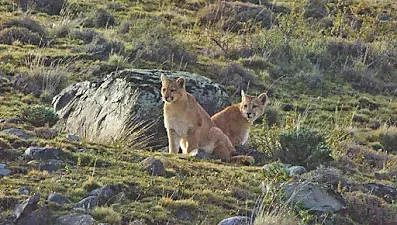________________
Has there been an increase in cougar sightings in the area? In a conversation with Emol, Michael Arcos, the Technical Coordinator and Park Ranger of CONAF (National Forest Corporation), explained that indeed, more specimens have been spotted lately. He added that this is mainly due to two reasons:
As a result of the 2005 forest fire, tall vegetation was reduced, providing fewer obstacles for cougars to hide. Additionally, there are more people in the park equipped with better means to record sightings," Arcos concluded.
 |
| Couple of Pumas Image: La Prensa Austral |
Likewise, the Veterinarian, and former General Coordinator of Fauna Invasora of the Servicio Agrícola y Ganadero de Magallanes, José Cabello, said that 'tourism' in previous years made this new relationship between the wild felids and travelers possible.
'Pumas born in 2004, when tourism began, are the adults that we can see now, they are used to seeing people. It is a friendly human presence that does not hunt and kill them, so they respond as they respond to any element of the landscape,' he said.
Higher density areas
Silva, who conducts an annual census of the species in Torres del Paine, notes that 'the peninsula'—referring to the area between Lakes Sarmiento, Nordenskjold, and Pehoe—has the highest density of Pumas, making sightings more frequent there.
Arcos also included the 'Sendero Aonikenk' (Aonikenk Trail) on the list as a common residence for Pumas. This underscores that Pumas can be spotted throughout the reserve, except in inhospitable areas.
"The density in that place is higher, but the Puma's potential territory is almost the entire park, with the exception of high mountain areas, glaciers, and lakes, of course," said the park ranger.
Cabello also identified some private areas with a large population of Pumas, which could be earmarked for tourism involving these animals. "Estancia Laguna Amarga, Cerro Paine, and Cerro Guido are areas of frequent Puma sightings," said the veterinarian, a specialist in native species.
Upcoming Regulations
Although it has not yet been reviewed by the respective authority, the researcher provided Emol with some potential safety guidelines that will be included in the proposal and could be integrated into the current security system of the reserve.
* Responsibility: Visitors to the areas inhabited by cougars must be informed that they are potentially dangerous animals, carrying implicit risks that visitors should be aware of.
* Equipment: Visitors should avoid wearing multicolored clothing to prevent disturbance to the landscape.

.webp)
Comments
Post a Comment